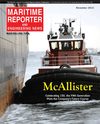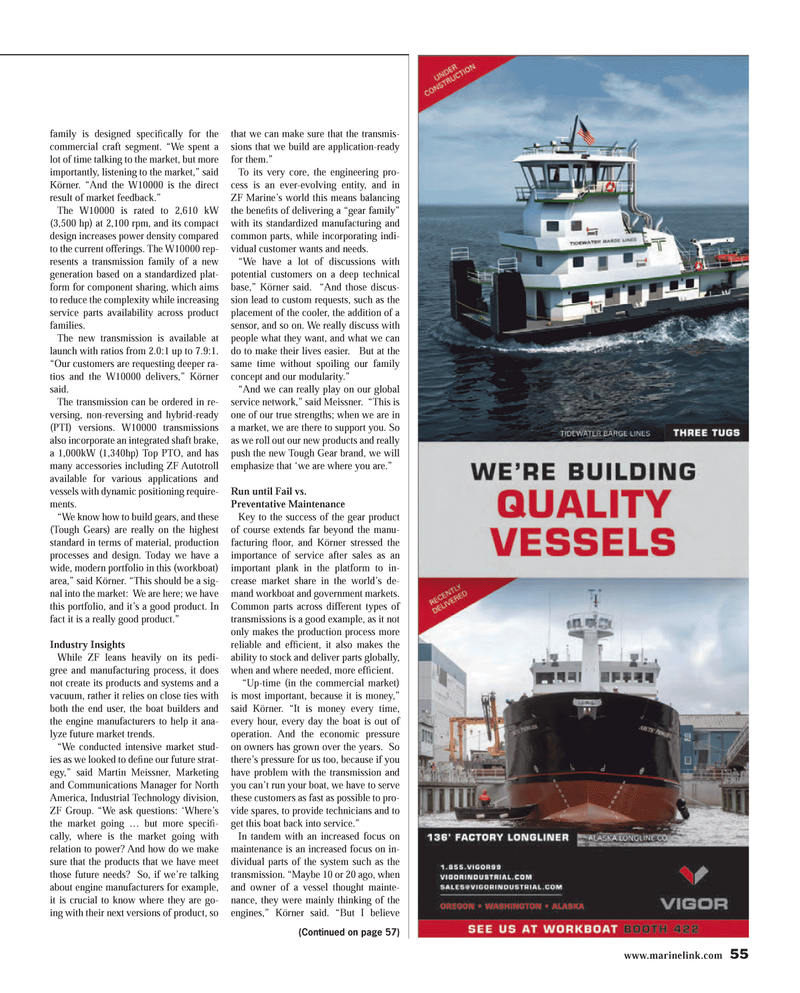
Page 55: of Maritime Reporter Magazine (November 2014)
Workboat Edition
Read this page in Pdf, Flash or Html5 edition of November 2014 Maritime Reporter Magazine
www.marinelink.com 55 family is designed speci? cally for the commercial craft segment. “We spent a lot of time talking to the market, but more importantly, listening to the market,” said
Körner. “And the W10000 is the direct result of market feedback.”
The W10000 is rated to 2,610 kW (3,500 hp) at 2,100 rpm, and its compact design increases power density compared to the current offerings. The W10000 rep- resents a transmission family of a new generation based on a standardized plat- form for component sharing, which aims to reduce the complexity while increasing service parts availability across product families.
The new transmission is available at launch with ratios from 2.0:1 up to 7.9:1. “Our customers are requesting deeper ra- tios and the W10000 delivers,” Körner said.
The transmission can be ordered in re- versing, non-reversing and hybrid-ready (PTI) versions. W10000 transmissions also incorporate an integrated shaft brake, a 1,000kW (1,340hp) Top PTO, and has many accessories including ZF Autotroll available for various applications and vessels with dynamic positioning require- ments. “We know how to build gears, and these (Tough Gears) are really on the highest standard in terms of material, production processes and design. Today we have a wide, modern portfolio in this (workboat) area,” said Körner. “This should be a sig- nal into the market: We are here; we have this portfolio, and it’s a good product. In fact it is a really good product.”
Industry Insights
While ZF leans heavily on its pedi- gree and manufacturing process, it does not create its products and systems and a vacuum, rather it relies on close ties with both the end user, the boat builders and the engine manufacturers to help it ana- lyze future market trends. “We conducted intensive market stud- ies as we looked to de? ne our future strat- egy,” said Martin Meissner, Marketing and Communications Manager for North
America, Industrial Technology division,
ZF Group. “We ask questions: ‘Where’s the market going … but more speci? - cally, where is the market going with relation to power? And how do we make sure that the products that we have meet those future needs? So, if we’re talking about engine manufacturers for example, it is crucial to know where they are go- ing with their next versions of product, so that we can make sure that the transmis- sions that we build are application-ready for them.”
To its very core, the engineering pro- cess is an ever-evolving entity, and in
ZF Marine’s world this means balancing the bene? ts of delivering a “gear family” with its standardized manufacturing and common parts, while incorporating indi- vidual customer wants and needs. “We have a lot of discussions with potential customers on a deep technical base,” Körner said. “And those discus- sion lead to custom requests, such as the placement of the cooler, the addition of a sensor, and so on. We really discuss with people what they want, and what we can do to make their lives easier. But at the same time without spoiling our family concept and our modularity.” “And we can really play on our global service network,” said Meissner. “This is one of our true strengths; when we are in a market, we are there to support you. So as we roll out our new products and really push the new Tough Gear brand, we will emphasize that ‘we are where you are.”
Run until Fail vs.
Preventative Maintenance
Key to the success of the gear product of course extends far beyond the manu- facturing ? oor, and Körner stressed the importance of service after sales as an important plank in the platform to in- crease market share in the world’s de- mand workboat and government markets.
Common parts across different types of transmissions is a good example, as it not only makes the production process more reliable and ef? cient, it also makes the ability to stock and deliver parts globally, when and where needed, more ef? cient. “Up-time (in the commercial market) is most important, because it is money,” said Körner. “It is money every time, every hour, every day the boat is out of operation. And the economic pressure on owners has grown over the years. So there’s pressure for us too, because if you have problem with the transmission and you can’t run your boat, we have to serve these customers as fast as possible to pro- vide spares, to provide technicians and to get this boat back into service.”
In tandem with an increased focus on maintenance is an increased focus on in- dividual parts of the system such as the transmission. “Maybe 10 or 20 ago, when and owner of a vessel thought mainte- nance, they were mainly thinking of the engines,” Körner said. “But I believe (Continued on page 57)
MR #11 (50-57).indd 55 10/30/2014 9:43:59 AM

 54
54

 56
56
